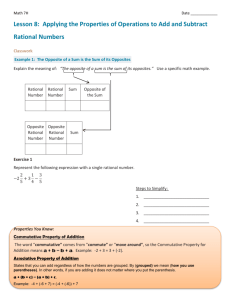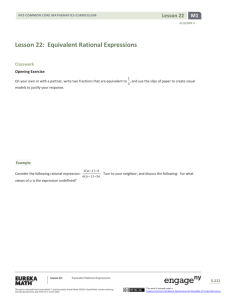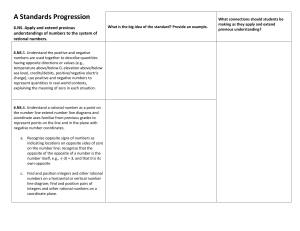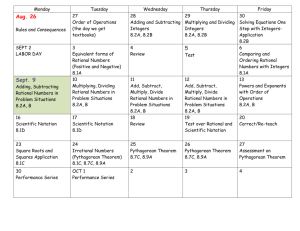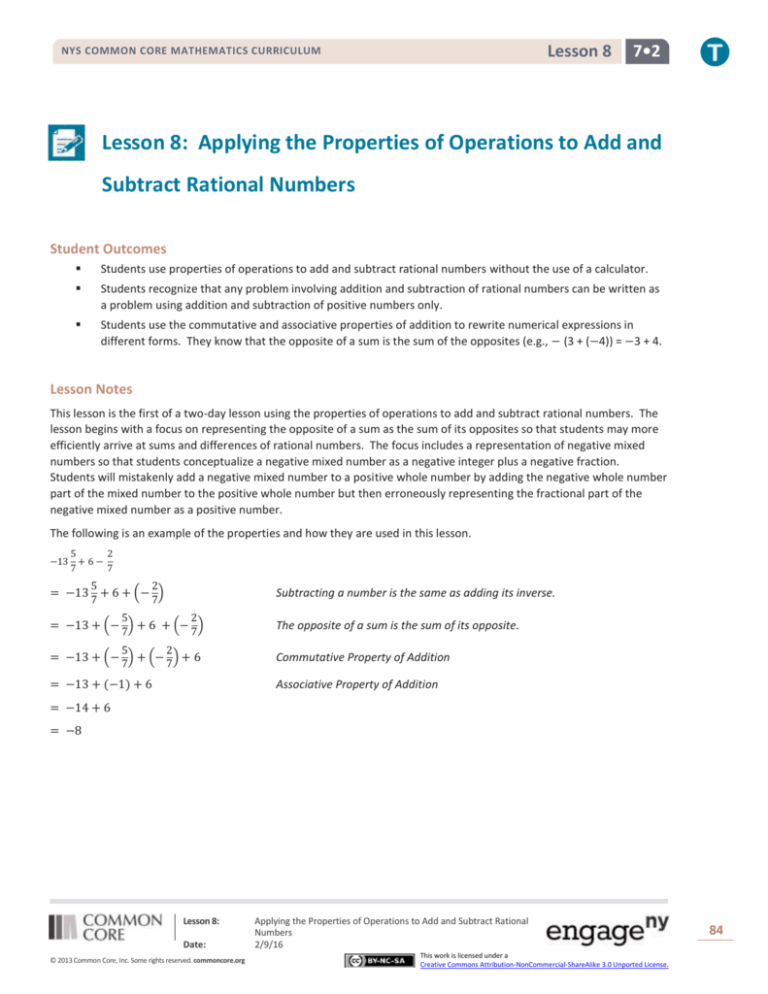
Lesson 8
NYS COMMON CORE MATHEMATICS CURRICULUM
7•2
Lesson 8: Applying the Properties of Operations to Add and
Subtract Rational Numbers
Student Outcomes
Students use properties of operations to add and subtract rational numbers without the use of a calculator.
Students recognize that any problem involving addition and subtraction of rational numbers can be written as
a problem using addition and subtraction of positive numbers only.
Students use the commutative and associative properties of addition to rewrite numerical expressions in
different forms. They know that the opposite of a sum is the sum of the opposites (e.g., − (3 + (−4)) = −3 + 4.
Lesson Notes
This lesson is the first of a two-day lesson using the properties of operations to add and subtract rational numbers. The
lesson begins with a focus on representing the opposite of a sum as the sum of its opposites so that students may more
efficiently arrive at sums and differences of rational numbers. The focus includes a representation of negative mixed
numbers so that students conceptualize a negative mixed number as a negative integer plus a negative fraction.
Students will mistakenly add a negative mixed number to a positive whole number by adding the negative whole number
part of the mixed number to the positive whole number but then erroneously representing the fractional part of the
negative mixed number as a positive number.
The following is an example of the properties and how they are used in this lesson.
5
2
−13 + 6 −
7
7
5
7
2
7
= −13 + 6 + (− )
Subtracting a number is the same as adding its inverse.
5
7
2
7
= −13 + (− ) + 6 + (− )
5
7
2
7
The opposite of a sum is the sum of its opposite.
= −13 + (− ) + (− ) + 6
Commutative Property of Addition
= −13 + (−1) + 6
Associative Property of Addition
= −14 + 6
= −8
Lesson 8:
Date:
© 2013 Common Core, Inc. Some rights reserved. commoncore.org
Applying the Properties of Operations to Add and Subtract Rational
Numbers
2/9/16
This work is licensed under a
Creative Commons Attribution-NonCommercial-ShareAlike 3.0 Unported License.
84
Lesson 8
NYS COMMON CORE MATHEMATICS CURRICULUM
7•2
Classwork
Activity 1 (3 minutes): Recall of a Number’s Opposite
This warm-up will prepare students for Exercise 1. Ahead of time, post a large number line
on the side wall (either in poster form or with painter’s tape.)
As students enter the room, hand them a small sticky note with a rational number on it.
Ask them to “find their opposite.” (Sticky notes will be such that each signed number has
a “match” for opposite.) Students pair up according to opposites, walk to the number line
on the side wall, and stick their numbers in the correct locations on the number line. The
class comes to consensus that all numbers are placed in the correct location.
Example 1 (5 minutes): The Opposite of a Sum is the Sum of its Opposites
Have the following statement up on the board: “The opposite of a sum is the sum of its
opposites.” Tell students we are going to use some numbers from the opening activity to
investigate this statement.
Scaffolding:
Select specific cards to
give to students to
challenge them at their
level.
Scaffolding:
Display an anchor poster
in the classroom to show
the meaning of “The
opposite of a sum is the
sum of its opposites.”
Label the “opposite” and
“sum” in a specific math
example.
Ask two pairs of students (who were partners from Activity 1) to come to the front of the
room. (Choose students who had rational numbers that were integers, as they will be
easier to understand in this example.) Have one person from each pair write their numbers on the board; let’s say they
were 7 and −2. Then find the sum, 7 + −2 = 5, and then find the opposite of the sum, −5. Now have their partners
write their numbers on the board, −7 and 2, and then find the sum of these opposites, −5. Now we can see that the
opposite of the sum is equal to the sum of the opposites.
Example 1
Explain the meaning of “The opposite of a sum is the sum of its opposites.” Use a specific math example.
Rational
Number
7
Rational
Number
−2
Opposite
Rational
Number
−7
Opposite
Rational
Number
2
Sum
Opposite of
the Sum
−5
5
Sum
−5
It means that if you have a sum and want to take the opposite, for instance, −(𝟕 + (−𝟐)), you can rewrite it as the sum
of each addend’s opposite: −𝟕 + 𝟐.
Exercise 1 (5 minutes)
Have students arrive at an answer to the following. Students share their different strategies with the class. The class
members discuss the strategies they used. They determine which are most efficient, which ways are less likely to cause
errors and confusion, whether they were able to reach the correct answer, etc. If no students share the solution method
on the right, share it with the class.
Lesson 8:
Date:
© 2013 Common Core, Inc. Some rights reserved. commoncore.org
Applying the Properties of Operations to Add and Subtract Rational
Numbers
2/9/16
This work is licensed under a
Creative Commons Attribution-NonCommercial-ShareAlike 3.0 Unported License.
85
Lesson 8
NYS COMMON CORE MATHEMATICS CURRICULUM
7•2
Exercise 1
Represent the following expression with a single rational number.
𝟐
𝟏 𝟑
−𝟐 + 𝟑 −
𝟓
𝟒 𝟓
Two Possible Methods:
−𝟐
𝟖
𝟓 𝟏𝟐
+𝟑
−
𝟐𝟎
𝟐𝟎 𝟐𝟎
𝟏𝟕 𝟏𝟐
−
𝟐𝟎 𝟐𝟎
𝟓
𝟏
𝒐𝒓
𝟐𝟎
𝟒
OR
Commutative Property:
𝟐
𝟏
𝟑
−𝟐 + 𝟑 + (− )
𝟓
𝟒
𝟓
𝟐
𝟑
𝟏
−𝟐 + (− ) + 𝟑
𝟓
𝟓
𝟒
𝟓
𝟏
−𝟐 + 𝟑
𝟓
𝟒
𝟏
−𝟑 + 𝟑
𝟒
𝟏
=
𝟒
After the students share their strategies, the following are questions that may guide the whole-group discussion.
Was it difficult for you to add the mixed numbers with different signs and denominators? Why or why not?
Were you able to arrive at the correct answer?
Which method do you prefer?
Which method is more challenging for you?
Example 2 (5 minutes): A Mixed Number is a Sum
2
5
The following example allows students to focus on a mixed number as a sum. Looking at 2 , they think about how it can
2
5
2
5
be rewritten using addition. (It means 2 + .) Once students represent it as a sum, they recognize that −2 means
2
5
−2 + (− ) . The following is a possible lead-in question.
2
5
2
5
−2 is the opposite of 2 . How can we show “the opposite of a sum is the sum of its opposites” with the
2
5
number −2 ? How do we model it on a number line?
Lesson 8:
Date:
© 2013 Common Core, Inc. Some rights reserved. commoncore.org
Applying the Properties of Operations to Add and Subtract Rational
Numbers
2/9/16
This work is licensed under a
Creative Commons Attribution-NonCommercial-ShareAlike 3.0 Unported License.
86
Lesson 8
NYS COMMON CORE MATHEMATICS CURRICULUM
7•2
Example 2
𝟐
𝟓
Use the number line model shown below to explain and write the opposite of 𝟐 as a sum of two rational numbers.
The opposite of 𝟐
𝟐
𝟐
is −𝟐 .
𝟓
𝟓
𝟐
𝟓
𝟐
𝟓
−𝟐 written as the sum of two rational numbers is −𝟐 + (− ).
Exercise 2 (3 minutes)
Students independently rewrite each mixed number as the sum of two signed numbers. Teacher circulates the room
providing assistance as needed. After two minutes, discuss the answers as a whole group.
Scaffolding:
Provide students with a
Exercise 2
laminate copy of the
Rewrite each mixed number as the sum of two signed numbers.
number line model used in
Example 2. Also provide
number lines so they can
represent each of the
𝟓
𝟓
a.
−𝟗
−𝟗 + (− )
𝟖
𝟖
following as a sum on the
number line.
b.
−𝟐
c.
𝟖
𝟏
𝟐
𝟏
𝟐
−𝟐 + (− )
𝟏𝟏
𝟏𝟐
𝟖+
Lesson 8:
Date:
© 2013 Common Core, Inc. Some rights reserved. commoncore.org
𝟏𝟏
𝟏𝟐
Applying the Properties of Operations to Add and Subtract Rational
Numbers
2/9/16
This work is licensed under a
Creative Commons Attribution-NonCommercial-ShareAlike 3.0 Unported License.
87
Lesson 8
NYS COMMON CORE MATHEMATICS CURRICULUM
7•2
Exercise 3 (3 minutes)
MP.8 Students independently use the reverse process to represent each sum or difference as a mixed number.
The teacher circulates the room providing assistance as needed. After two minutes, discuss the answers as a whole
group.
Exercise 3
Represent each sum as a mixed number.
𝟓
)
𝟏𝟐
a.
−𝟏 + (−
b.
𝟑𝟎 +
c.
−𝟏𝟕 + (− )
𝟏
𝟖
𝟏
𝟗
−𝟏
𝟓
𝟏𝟐
𝟑𝟎
𝟏
𝟖
−𝟏𝟕
𝟏
𝟗
Note: Exercises 3 and 4 are designed to provide students with an opportunity to practice writing mixed numbers as
sums so they can do so as the need arises in more complicated problems.
Exercise 4 (5 minutes)
Students work independently to solve the problem below. Then student volunteers share their steps and solutions with
the class. Note, the solution below includes just one possible solution method. However, a common mistake is for
1
students to arrive at an incorrect answer of −5 . As needed, revisit subtracting a mixed number from a whole number.
8
Exercise 4
𝟏
𝟖
Mr. Mitchell lost 10 pounds over the summer by jogging each week. By winter time, he had gained 𝟓 pounds.
Represent this situation with an expression involving signed numbers. What is the overall change in Mr. Mitchell’s
weight?
−𝟏𝟎 + 𝟓
𝟏
𝟖
= −𝟏𝟎 + 𝟓 +
𝟏
𝟖
= (−𝟏𝟎 + 𝟓) +
= (−𝟓) +
= −𝟒
𝟏
𝟖
𝟏
𝟖
𝟕
𝟖
Mr. Mitchell’s weight dropped by 𝟒
Lesson 8:
Date:
© 2013 Common Core, Inc. Some rights reserved. commoncore.org
𝟕
pounds.
𝟖
Applying the Properties of Operations to Add and Subtract Rational
Numbers
2/9/16
This work is licensed under a
Creative Commons Attribution-NonCommercial-ShareAlike 3.0 Unported License.
88
Lesson 8
NYS COMMON CORE MATHEMATICS CURRICULUM
7•2
Exercise 5 (8 minutes)
MP.1 Students work with a partner to complete the following exercise. Students make sense of each step and come up with
an alternate method of solving the problem.
After five minutes, class resumes as a whole group, and students volunteer verbal explanations and their own methods
for solving the problem.
Exercise 5
𝟓
𝟐
𝟕
𝟕
Jamal is completing a math problem and represents the expression −𝟓 + 𝟖 − 𝟑 with a single rational number as shown
in the steps below. Justify each of Jamal’s steps. Then, show another way to solve the problem.
𝟓
𝟐
= −𝟓 + 𝟖 + (−𝟑 )
𝟕
𝟕
Scaffolding:
Provide a list of the
Properties of Operations
as a reference sheet or as
a bookmark for students.
𝟓
𝟐
= −𝟓 + (−𝟑 ) + 𝟖
𝟕
𝟕
𝟓
𝟐
= −𝟓 + (− ) + (−𝟑) + (− ) + 𝟖
𝟕
𝟕
𝟓
𝟐
= −𝟓 + (− ) + (− ) + (−𝟑) + 𝟖
𝟕
𝟕
= −𝟓 + (−𝟏) + (−𝟑) + 𝟖
= −𝟔 + (−𝟑) + 𝟖
= (−𝟗) + 𝟖
= −𝟏
Step 1:
Subtracting a number is the same as adding its inverse.
Step 2:
Apply the commutative property of addition.
Step 3:
The opposite of a sum is the sum of its opposites.
Step 4:
Apply the commutative property of addition.
Step 5:
Apply the associative property of addition.
𝟓
𝟐
𝟕
(− ) + (− ) = (− ) = −𝟏
𝟕
𝟕
𝟕
Step 6:
−𝟓 + (−𝟏) = −𝟔
Step 7:
−𝟔 + −𝟑 = −𝟗
Step 8:
−𝟗 + 𝟖 = −𝟏
Answers will vary for other methods of reaching a single rational number. Students may choose to add −𝟓
𝟓
𝟐
together first, but a common mistake is to represent their sum as 𝟑 rather than 𝟐 .
𝟕
𝟕
Lesson 8:
Date:
© 2013 Common Core, Inc. Some rights reserved. commoncore.org
𝟓
𝒂𝒏𝒅 𝟖
𝟕
Applying the Properties of Operations to Add and Subtract Rational
Numbers
2/9/16
This work is licensed under a
Creative Commons Attribution-NonCommercial-ShareAlike 3.0 Unported License.
89
Lesson 8
NYS COMMON CORE MATHEMATICS CURRICULUM
7•2
Closing (2 minutes)
How can we rewrite the opposite of a sum?
As the sum of its opposites
How is it helpful when finding the sums and differences of rational numbers to use the properties of
operations?
It allows us to regroup terms so that we can efficiently arrive at an answer. For instance, in an
expression we may wish to first combine certain rational numbers that are in decimal form or those
that are in fractional form. Or, we may wish to group together all the negative numbers if we are
finding the sum of positive and negative numbers.
Lesson Summary
Use the properties of operations to add and subtract rational numbers more efficiently. For instance:
𝟐
𝟐
𝟐
𝟐
−𝟓 + 𝟑. 𝟕 + 𝟓 = (−𝟓 + 𝟓 ) + 𝟑. 𝟕 = 𝟎 + 𝟑. 𝟕 = 𝟑. 𝟕
𝟗
𝟗
𝟗
𝟗
The opposite of a sum is the sum of its opposites as shown in the examples that follow:
−𝟒
𝟒
𝟒
= −𝟒 + (− )
𝟕
𝟕
−(𝟓 + 𝟑) = −𝟓 + (−𝟑)
Exit Ticket (6 minutes)
Lesson 8:
Date:
© 2013 Common Core, Inc. Some rights reserved. commoncore.org
Applying the Properties of Operations to Add and Subtract Rational
Numbers
2/9/16
This work is licensed under a
Creative Commons Attribution-NonCommercial-ShareAlike 3.0 Unported License.
90
Lesson 8
NYS COMMON CORE MATHEMATICS CURRICULUM
Name ___________________________________________________
7•2
Date____________________
Lesson 8: Applying the Properties of Operations to Add and
Subtract Rational Numbers
Exit Ticket
Mariah and Shane both started to work on a math problem and were comparing their work in math class. Are both of
their representations correct? Explain, and finish the math problem correctly to arrive at the correct answer.
Math Problem
Jessica’s friend lent her $5. Later that day Jessica gave her
3
4
friend back 1 dollars.
Which rational number represents the overall change to the
amount of money Jessica’s friend has?
Mariah started the problem as follows:
3
−5 − (−1 )
4
Shane started the problem as follows:
3
−5 − (−1 )
3
= −5 + 1 −
4
4
3
= −5 + (1 )
4
3
= −5 + (1 + )
4
__________________________________________________________________________________
__________________________________________________________________________________
__________________________________________________________________________________
__________________________________________________________________________________
__________________________________________________________________________________
Lesson 8:
Date:
© 2013 Common Core, Inc. Some rights reserved. commoncore.org
Applying the Properties of Operations to Add and Subtract Rational
Numbers
2/9/16
This work is licensed under a
Creative Commons Attribution-NonCommercial-ShareAlike 3.0 Unported License.
91
Lesson 8
NYS COMMON CORE MATHEMATICS CURRICULUM
7•2
Exit Ticket Sample Solutions
Mariah and Shane both started to work on a math problem and were comparing their work in math class. Are both of
their representations correct? Explain, and finish the math problem correctly to arrive at the correct answer.
Math Problem
Jessica’s friend lent her $𝟓. Later that day Jessica gave her
𝟑
𝟒
friend back 𝟏 dollars.
Which rational number represents the overall change to
the amount of money Jessica’s friend has?
Mariah started the problem as follows:
Shane started the problem as follows:
𝟑
𝟒
𝟑
𝟒
−𝟓 − (−𝟏 )
= −𝟓 + 𝟏 −
−𝟓 − (−𝟏 )
𝟑
𝟒
𝟑
𝟒
= −𝟓 + (𝟏 )
= −𝟓 + (𝟏 +
𝟑
)
𝟒
Shane’s method is correct. In Mariah’s math work, she only dealt with part of the mixed number. The fractional part
𝟑
𝟒
𝟑
𝟑
𝟒
should have been positive too, because the opposite of −𝟏 is 𝟏 , which contains both a positive 1 and a positive . The
𝟒
correct work would be
𝟑
𝟒
𝟑
𝟒
𝟑
𝟒
−𝟓 − (−𝟏 ) = −𝟓 + (𝟏 ) = −𝟓 + (𝟏 + ) = (−𝟓 + 𝟏) +
The rational number would be −𝟑
𝟑
𝟑
𝟏
= −𝟒 + = −𝟑 .
𝟒
𝟒
𝟒
𝟏
, which means Jessica’s friend gave away 𝟑 𝟏𝟒 dollars, or $3.25.
𝟒
Problem Set Sample Solutions
1.
Represent each sum as a single rational number.
𝟖
𝟗
a.
−𝟏𝟒 + (− )
b.
𝟕+
c.
−𝟑 + (−
𝟏
𝟗
−𝟏𝟒
𝟖
𝟗
𝟏
𝟗
𝟏
−𝟑
𝟔
𝟕
𝟏
)
𝟔
Rewrite each of the following to show that the opposite of a sum is the sum of the opposites. Problem 4 has been
completed as an example.
2.
−(𝟗 + 𝟖) = −𝟗 + (−𝟖)
−𝟏𝟕
=
−𝟏𝟕
Lesson 8:
Date:
© 2013 Common Core, Inc. Some rights reserved. commoncore.org
Answer provided in student materials.
Applying the Properties of Operations to Add and Subtract Rational
Numbers
2/9/16
This work is licensed under a
Creative Commons Attribution-NonCommercial-ShareAlike 3.0 Unported License.
92
Lesson 8
NYS COMMON CORE MATHEMATICS CURRICULUM
𝟏
𝟒
7•2
𝟏
𝟒
− ( + 𝟔) = − + (−𝟔)
−𝟔
4.
𝟏
𝟏
= −𝟔
𝟒
𝟒
−(𝟏𝟎 + (−𝟔)) = −𝟏𝟎 + 𝟔
− 𝟒 = −𝟒
5.
𝟏
𝟐
𝟓𝟒
6.
𝟏
𝟐
− ((−𝟓𝟓) + ) = 𝟓𝟓 + (− )
𝟏
𝟏
= 𝟓𝟒
𝟐
𝟐
Meghan said the opposite of the sum of −12 and 4 is 8. Do you agree? Why or why not?
Yes, I agree. The sum of −12 and 4 is −8, and the opposite of −8 is 8.
7.
Jolene lost her wallet at the mall. It had $10 in it. When she got home her brother felt sorry for her and gave her
$𝟓. 𝟕𝟓. Represent this situation with an expression involving rational numbers. What is the overall change in the
amount of money Jolene has?
−𝟏𝟎 + 𝟓. 𝟕𝟓 = −𝟒. 𝟐𝟓. The overall change in the amount of money Jolene has is -4.25 dollars.
8.
𝟏
𝟓
Isaiah is completing a math problem and is at the last step: 𝟐𝟓 − 𝟐𝟖 . What is the answer? Show your work.
𝟏
𝟓
𝟏
𝟓
𝟏
𝟓
𝟏
𝟓
𝟐𝟓 − 𝟐𝟖 = 𝟐𝟓 + (−𝟐𝟖 + (− )) = (𝟐𝟓 + −𝟐𝟖) + (− ) = −𝟑 .
9.
A number added to its opposite equals zero. What do you suppose is true about a sum added to its opposite?
Use the following examples to reach a conclusion. Express the answer to each example as a single rational number.
𝑨 sum added to its opposite is zero.
a.
(𝟑 + 𝟒) + (−𝟑 + −𝟒) = 𝟕 + (−𝟕) = 𝟎.
b.
(−𝟖 + 𝟏) + (𝟖 + (− 𝟏)) = (−𝟕) + 𝟕 = 𝟎.
c.
(− + (− )) + ( + ) = (− ) +
𝟏
𝟐
𝟏
𝟒
𝟏
𝟐
Lesson 8:
Date:
© 2013 Common Core, Inc. Some rights reserved. commoncore.org
𝟏
𝟒
𝟑
𝟒
𝟑
= 𝟎.
𝟒
Applying the Properties of Operations to Add and Subtract Rational
Numbers
2/9/16
This work is licensed under a
Creative Commons Attribution-NonCommercial-ShareAlike 3.0 Unported License.
93



